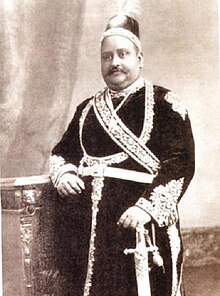This article possibly contains original research. (December 2022) |

A zamindar[a] in the Indian subcontinent was an autonomous or semi-autonomous feudal ruler of a zamindari (feudal estate). The term itself came into use during the reign of Mughals, and later the British began using it as a native synonym for "estate". The term means landowner in Persian. They were typically hereditary and held the right to collect tax on behalf of imperial courts or for military purposes.
During the period of British colonial rule in India many wealthy and influential zamindars were bestowed with princely and royal titles such as Maharaja, Raja/Rai, Babu, Malik, Chaudhary, Nawab, Khan and Sardar.
During the Mughal Empire, as well as the British rule, zamindars were the land-owning nobility of the Indian subcontinent[1] and formed the ruling class. Emperor Akbar granted them mansabs and their ancestral domains were treated as jagirs.[2] Majority of the big Zamindars were from the Hindu high-caste, usually Brahmin, Bhumihar, Kayastha and Rajput.[3] During the colonial era, the Permanent Settlement consolidated what became known as the zamindari system. The British rewarded supportive zamindars by recognising them as princes. Many of the region's princely states were pre-colonial zamindar holdings elevated to a greater protocol. The British also reduced the land holdings of many pre-colonial princely states and chieftaincies, demoting their status to a zamindar from previously higher ranks of royalty.[citation needed]
The system was abolished during land reforms in East Pakistan (Bangladesh) in 1950,[4] India in 1951[5] and West Pakistan in 1959.[6] The zamindars often played an important role in the regional histories of the subcontinent. One of the most notable examples is the 16th-century confederation formed by twelve zamindars in the Bhati region (Baro-Bhuyans), which, according to the Jesuits and Ralph Fitch, earned a reputation for successively repelling Mughal invasions through naval battles. The zamindars were also patrons of the arts. The Tagore family produced India's first Nobel laureate in literature in 1913, Rabindranath Tagore, who was often based at his estate. The zamindars also promoted neoclassical and Indo-Saracenic architecture.
Cite error: There are <ref group=lower-alpha> tags or {{efn}} templates on this page, but the references will not show without a {{reflist|group=lower-alpha}} template or {{notelist}} template (see the help page).
- ^ Metcalf, Barbara Daly (1984). Moral conduct and authority: the place of adab in South Asian Islam. University of California Press. p. 269. ISBN 9780520046603. Archived from the original on 8 March 2023. Retrieved 15 November 2015.
- ^ Acharya, Shreya (30 October 2011). "Give an account of the Ruling Classes of Mughal Empire". preservearticles.com. Archived from the original on 21 May 2013.
- ^ Choithani, Chetan (11 May 2023). Migration, Food Security and Development. Cambridge University Press. p. 106. ISBN 978-1-108-84037-8.
- ^ Baxter, C (1997). Bangladesh, from a Nation to a State. Westview Press. p. 72. ISBN 0-8133-3632-5.
- ^ "Abolition of Zamindari in India". gktoday.in. General Knowledge Today. Archived from the original on 30 November 2016.
- ^ "Land reforms in Pakistan". Dawn.com. 11 October 2010. Archived from the original on 30 November 2016.